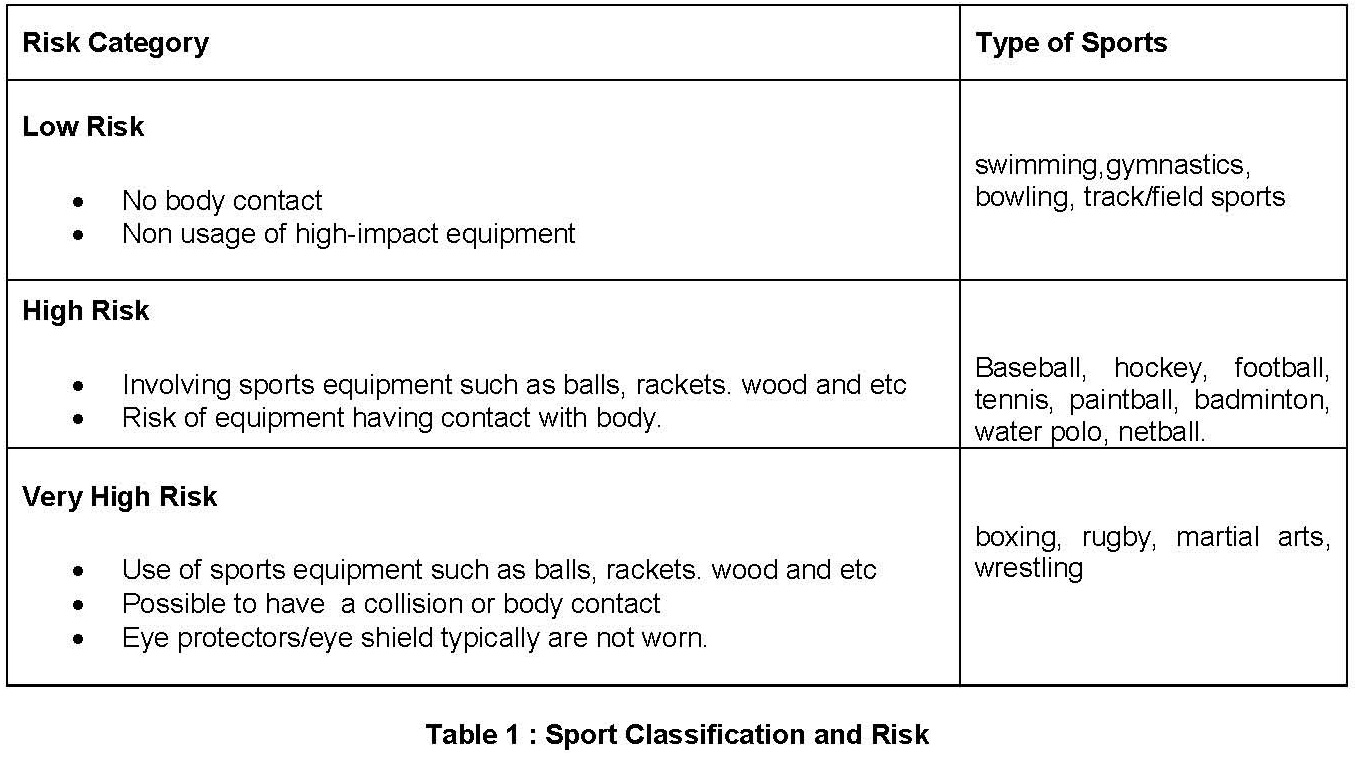Introduction
Sport is an activity that is good for health. However, studies have found that there are increasing trend in cases of eye injuries due to sport accidents.
It can happened to all age and the severity of eye injuries depends on the type of sport, the equipment used, the hardness and speed of the object, and the nature of the sport itself.
Eye injuries related to sports, no matter how small, are capable of causing serious injury and permanent damage to the human eye.
Common Types of Eye Injuries Sustained During Sports
• Blunt trauma injuries:
Blunt object with high velocity hit the eyes eg; balls, rackets, etc.
• Penetrating injuries:
Cuts around the eye due to broken glasses penetration into the eyes
•Radiation injuries:
Excessive exposure to ultraviolet light from the sun such as skiing, golf , water sports, etc.

Common Eye Diseases Secondary to Sports-related eye injuries :
- Cornealscar
- Glaucoma
- Cataracts
- Squint
- Retina Detachment
Preparticipation Examination
A comprehensive eye examination should be done before playing any sport. Perform eyes check up by an eye doctor in order to know the condition of the eyes before playing any high-risk or very-high-risk sports.
Follow the advice and recommendations from your doctor or other expertise before the game. Tell your doctor if you have any eye problems or if you have a family history of retinal problems.
Tips for prevention ocular injuries during sports activities
- Protective eyewear should be worn. Studies had shown that 90 % of sports-related eye injuries can be prevented. Ordinary prescription glasses, contact lenses, and sunglasses do not give full protection to the eyes.
- For sports that has tendency for radiation exposure, it is advised to use the ultraviolet protective lenses which are able to absorb 99 percent of the ultraviolet light.
- Use a face shield with a specially designed helmet that will help to reduce high-speed objects hitting in the face and the head
- Parents and coaches should insist that children wear protective eyewear whenever they play sports and encourge to be good role models. Follow all safety guidelines.
- Always ready with a well maintained and well equipped first aid box.
Protective Eyewear and The Benefits
The American Society for Testing and Materials (ASTM) has issued standard guidelines on the selection of eye protector devices. According to the standard given, protective eyewear should consist of safety glasses or safety shield made of polycarbonate lenses.
This lens has the ability of 8 to 10 times impact resistant than other plastics lens. They are the thinnest, lightest lenses available, not easy to scratch and are able to absorb ultraviolet radiation.
This lens can be prescribed by a doctor, ophthalmologists, optometrists or opticians according to the eye needs.

Figure 1 : examples of eye protection
What to do in case of eye injuries during sports
Several guidelines for returning to play after an injury should be followed. For patients with significant ocular injury, a full examination and clearance by an ophthalmologist are required.
The player shall return to play only if the doctor says it is safe. Please ensure wearing of eye protectors at all times. The injured eye should feel better, comfortable and have adequate vision before returning to play. Do not use any topical anesthetics in order to keep playing when pain recurs.
References
- Modern sports eye injuries : J A Capa ?o Filipe, A Rocha-Sousa, F Falca ?o-Reis, J Castro-Correia Br J Ophthalmol2003;87:1336–1339
- Harrison, A., & Telander, D.G. (2002). Eye Injuries in the youth athlete: a case-based approach. Sports Medicine, 31(1), 33-40.
- http://www.aafp.org/afp/2003/0401/p1494.html
- http://www.aafp.org/afp/2003/0401/p1481.html
- http://familydoctor.org/familydoctor/en/prevention-wellness/exercise-fitness/sports-safety/eye-injuries-in-sports.html
- https://www.willseye.org/how-to-prevent-eye-injuries
- http://visionsource-brookfield.com/vision-care-products/other-info/
- http://www.nei.nih.gov/sports/
- http://bjo.bmj.com/content/88/2/161.full.pdf
- http://optometrytimes.modernmedicine.com/optometrytimes/news/aoa-warns-against-basketball-related-ocular-injury
- http://www.geteyesmart.org/eyesmart/living/sports.cfm
- http://www.allaboutvision.com/sports/protection.htm
- http://www.hd
ickinson.co.uk/product_page.php?id=234
| Writer | : | Pn. Halijahton bt. Abdol Rahim |
| Last Reviewed | 14 August 2014 | |
| Accreditor | Pn. Rosmawati bt. Uthman |







